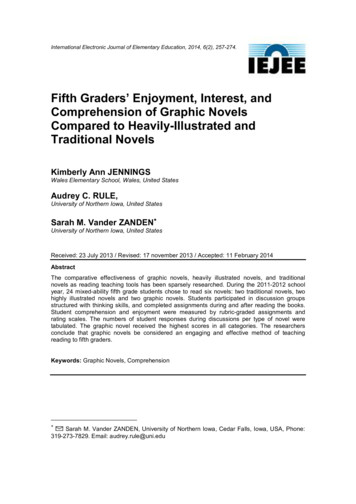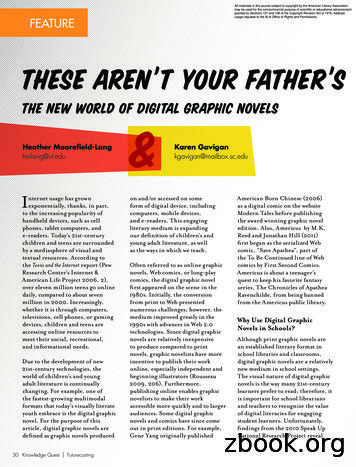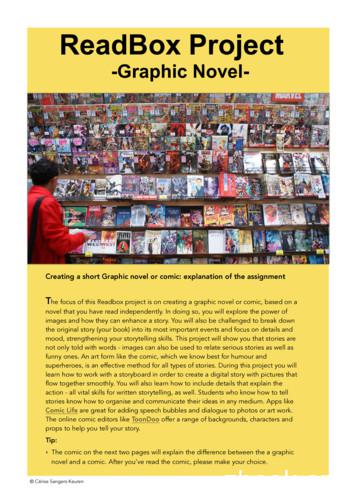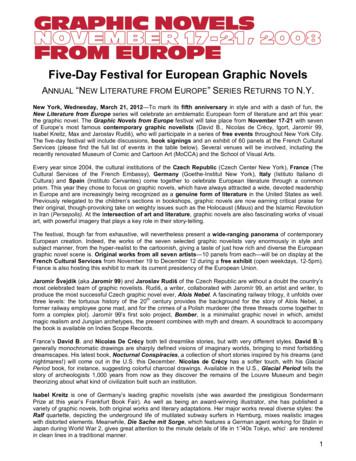More Than Graphic Novels Are Students In Almost Any Comic .
SPECIAL TOPICMore ThanComic BooksBill Boerman-CornellEvery few days for the pastthree weeks, I have beengiving a small pile of graphicnovels to my friend Mary.She then gives them to oneof her students at the high schoolwhere she teaches. He devours themwithin a day or two and sends themback. Through Mary, I have sent thisstudent original literature, nonfictionhistory, biographies of mathematicians,popular fantasy, adaptations of adolescent novels, memoirs, and anythingelse I can think of. He loves some of it,likes some of it, and really doesn’t carefor some of it, but he reads all of it andalways asks for more.Graphic novels (book-length fictionor nonfiction narratives told using theconventions of a comic book) bringtogether text and image in a way thatseems to capture students’ imaginations.Right now, there is little more thananecdotal research about how graphicnovels can be used within specificmiddle school and high school disciplines. But as we wait for the research tocatch up, we can learn a great deal fromlooking closely at the graphic novelsthemselves to see how they might meetteachers’ and students’ needs.Why Use Graphic Novels?Some of the best artists and writersworking today are focused on thisnew and exciting format. Take a lookat offerings likeRapunzel’s Revenge byDean Hale, ShannonHale, and Nathan Hale(Bloomsbury, 2008);George O’Connor’sexcellent series onGreek mythology (FirstSecond, 2010); T-Minusby Jim Ottaviani, ZanderCannon, and Kevin Cannon(Alladin, 2009); Satchel Paige:Striking Out Jim Crow by JamesSturm and Richard Tommaso(Hyperion, 2007); and Logicomixby Apostolos Doxiadis, Christos H.Papadimitriou, Alecos Papadatos, andAnnie Di Donna (Bloomsbury, 2009)to see the potential of graphic novels toengage students in literature, culture,science and engineering, history, andmathematics.Because graphic novels use imagesand text closely integrated together,reading them builds within studentsthe same skills they need for readingwebsites and magazines. At the sametime, they may also help students learntraditional reading skills. Strong readersuse their imaginations to turn wordson the page into images in their minds.Graphic novels may offer students whoare still developing imaging skills a wayto build these skills by giving themsome images but requiring them toimagine what happens between panels.Finally, graphic novels can be aneffective way to engage students whoGraphic novels arerelevant to teachers andstudents in almost anycontent area.don’t yet know that they love thesubject you are teaching.Dumbing Down?Like any format for telling stories andpassing on information, graphic novelsinclude a range of reading levels. Thematerial can be as rigorous as a physicstextbook or as vapid as a tween movieadaptation.Often, the images can act as a wayof making difficult concepts or textsmore comprehensible. For example,Journey into Mohawk Country is thediary of Dutch explorer Harman Vanden Bogaert’s 1634 journey amongthe Mohawk people in what is nownorthern New York State and Ontario todetermine why the Mohawk preferredtrading with the French over the Dutch.Van den Bogaert is not exactly a prosestylist; his diary is matter-of-fact andoften dull. Consider this entry:ASCD /Boerman-Cornell.indd 73WWW.ASCD.ORG732/1/13 11:50 AM
When we, by my estimation, had coveredeleven miles, we came at one hour intothe cabin one half mile from the firstcastle [village]. No one was there butwomen. We would have continued on,but I could not move my feet because ofthe rough going. So we slept there. It wasvery cold, with a north wind. (O’Connor& Van den Bogaert, 2006)The graphic novel adaptation byGeorge O’Connor (First Second, 2006)includes all the original text of thediary, but the images provide contextthat make the text more engaging andinsightful. For example, one sequenceshows the American Indian guidedrawing open the hide covering the hutClearly, the explorers are violating somesort of cultural taboo. Their guide isembarrassed. Throughout the rest ofthe book, the Dutch explorers displaycultural insensitivity again and again,which may explain why the Mohawkare not interested in trading with theDutch. Extensive notes at the end ofthe graphic novel describe O’Connor’sresearch.Guiding Graphic Novel ReadingBefore students read a graphic novel,their teacher needs to introduce someof the basic conventions of such novels.These conventions might include theusual arrangement of panels from left toThe term graphic novelis a misnomer. Not allgraphic novels arenovels; many of them arenonfiction—biography,memoir, or straightinformational nonfiction.that the group has approached. Whenthe guide sees there are only women inthe hut, he replaces the hide, looking atthe Dutch explorers with an expressionthat clearly indicates that this is not agood place for them to stop. In the nextpanel, the Dutch talk while the guidelooks on with a stern expression. Thenext panel shows the explorers pointingto their tired feet, and the guide hashis head down and a hand covering hiseyes. The next panel shows Van denBogaert entering the women’s hut, hiseyes wide.The images give students the contextthey need to draw some conclusions.74right and top to bottom, as well as waysof navigating alternative panel arrangements; the conventions of speech andthought bubble borders (smooth equalsnormal speech, jagged indicates anexcited voice, square or boxy indicatesa mechanical sort of speech, and so on);and the shading of text boxes to indicatewhich character is narrating the story.New graphic novel readers needto learn to make predictions on thebasis of not only the text, but also theimages. For example, the facial expressions of a character in the presence ofanother may imply a not-yet-revealedanimosity or friendship, and an image ofa potential hazard may portend a laterplot turn.Teachers should read the graphicnovel they intend to teach several timesand observe how these conventionsare used. The teacher does not need tobecome an expert, however. In graphicnovel book clubs I have conductedwith students in 3rd grade throughmiddle school, I have been amazed athow students have noticed storytellingtechniques that I missed in five or sixreadings.While students read, the teachermight ask them to show how they reada page, using their finger to indicatewhere their eye is going to check panelflow. The teacher might also ask questions about particular images, just ashe or she might about the words in atext-only story: What is that character’sattitude here? How can you tell? Also,just like with text-only works, asking astudent to summarize the story will givethe teacher a clear idea of whether thestudent is following the narrative.Graphic Novelsin the Content AreasThe term graphic novel is a misnomer.Not all graphic novels are novels; manyof them are nonfiction—biography,memoir, or straight informational nonfiction. Teachers in almost any discipline can find graphic novels for use intheir classes.MathLogicomix by Apostolos Doxiadis,Christos H. Papadimitriou, AlecosPapadatos, and Annie Di Donna(Bloomsbury, 2009) and Suspended inLanguage by Jim Ottaviani and LelandPurvis (G.T. Labs, 2004) illustratethe lives of mathematicians BertrandRussell and Niels Bohr. T-Minus by JimOttaviani, Zander Cannon, and KevinCannon (Alladin, 2009) is an amazingnarrative of the United States’ and SovietUnion’s race to the moon in which theengineers and mathematicians are asEDUCATIONAL LEADERSHIP / MARCH 2013Boerman-Cornell.indd 742/1/13 11:50 AM
much the heroes as the astronauts.Besides telling fascinating mathrelated stories, graphic novels can alsomodel mathematical problem solving.In T-Minus, an American engineer usesgeometry to figure out that the Sovietshadn’t really linked up two spacecraft inorbit; they just used perspective to makeit seem that they had done so. BertrandRussell’s explanation in Logicomix ofhow a tautology can be logical but notreally convey any information couldbe useful in lessons on mathematicallogic. Some graphic novels also employcryptography. Andrew Donkin andGiovanni Rigano’s graphic novel adaptation of Artemis Fowl (Hyperion, 2007)by Eoin Colfer is one example.Perhaps the greatest potential forteaching math through graphic novelslies in their ability to illustrate mathematical concepts by combining imageswith equations and explanations ofthe concepts under consideration. Suspended in Language is particularly goodat this.Social StudiesWineburg (1991) has suggested thatmiddle school and high school studentsshould be able to do more than justmemorize dates and names of famouspeople; they should be able to contextualize, corroborate, and source different historical events and documents.Graphic novels can help students withall these skills, although some graphicnovels do this better than others(Boerman-Cornell, 2012).Graphic novels are most effective atcontextualization. Images can providequick social, economic, and culturalcontext through their depictions ofclothing, buildings, transportation, andinterpersonal interactions during different periods in history. They also canuse panel divisions, parallel images,and text boxes to make quick yet cleartransitions from place to place and timeto time. This allows a graphic novelcreator to juxtapose similar momentsfrom several different events separatedby time.For example, the graphic novel Still IRise by Roland Laird and Taneshia NashLaird (Norton, 1997) depicts AfricanAmerican slaves’ choice between servingin the loyalist army or the revolutionaryarmy during the American Revolutionas a fork between two dangerous paths.A similar image appears 20 pageslater, when African Americans in the1960s have the choice between joblesspoverty and joining the army to fight inVietnam. The image encourages readersto consider similarities between the twomoments.Graphic novels canbe an effective wayto engage studentswho don’t yet knowthey love the subjectyou are teaching.Graphic novels also offer opportunities for corroboration by gatheringmultiple eyewitness accounts into asingle narrative. Joe Sacco, in both SafeArea Goražde (Fantagraphics, 2002) andPalestine (Fantagraphics, 2001), usesmany eyewitness reports. Sacco givesus a close-up of the face of the personwhose account we are going to read,coupled with a text of his or her name.The panels that follow, whether 2 or 20,are part of that person’s account.Graphic novels can also assist withcorroboration by requiring readers tointeract with primary sources and otherdocuments that traditional historybooks usually place in sidebars andappendixes that seem incidental to themain text. The late Howard Zinn, inA People’s History of American Empire(coauthored by Mike Konopacki andPaul Buhle [Metropolitan Books, 2008])embeds documents, newspaper articles,maps, charts, timelines, and more in thenarrative.Although some graphic novels carefully list sources, most do not do as wellwith sourcing as they do with the othertwo elements. Students could considersources on their own by examiningmultiple stories from the same period.For example, Art Spiegelman’s Maus(Pantheon, 1986), which tells a story ofWorld War II from the perspective of aHolocaust survivor, could be contrastedwith Carla Jablonski and Leland Purvis’sResistance (First Second, 2010), whichcovers the same period from the pointof view of French resistance fighters.However, nothing about graphic novelsseems to make them any better suitedto comparing sources than a regular textversion of a story would be.ScienceDisciplinary thinking in science requiresstudents to understand processes, usethe scientific method, and pay particularattention to the value of observation.Graphic novel creator Jay Hosler focuseson observations of both small andlarge processes. His Clan Apis (ActiveSynapse, 2000) follows the life of aASCD /Boerman-Cornell.indd 75WWW.ASCD.ORG752/1/13 11:50 AM
single bee. In so doing, he shows howecosystems work, why life cycles areimportant, and why the food chainis vital. Sandwalk Adventures (ActiveSynapse, 2003) uses the contrivance ofa conversation between Charles Darwinand a dust mite living on one of thehairs of his beard to examine the intricacies of natural selection and evolutionary theory.Books like Dignifying Science (G.T.Labs, 2009) and Laika (First Second,2007) can encourage kids to see scienceas something they could be part of. Dignifying Science by Jim Ottaviani, DonnaBarr, Mary Fleener, and Ramona Fradenspotlights several pioneering female sci-tension between the military’s need forsecrecy and the scientists’ need for openconversation. Feynman by Jim Ottavianiand Leland Myrick is a biography ofRichard Feynman, who was so excitedabout learning new things he seemed tonot care about the politics and securityissues that Oppenheimer struggled with.Language ArtsGraphic novels useful for language artscan be generally divided into two categories: adaptations of classic stories andother well-known texts (for example,Sir Arthur Conan Doyles’s Hound of theBaskervilles, which has been adaptedby multiple artists) and new works (forTeachers should notpresent graphic novelsas an alternativeto regular reading,but as adifferent anduseful format.entists. Laika by Nick Aranzis spotlightsthe Soviet dog who was the first animalto orbit the earth and the female scientist who took care of him.Some graphic novels also explorethe moral issues that scientists mayconfront. Fallout (G.T. Labs, 2001)and Feynman (First Second, 2011)present two different takes on howscience interacts with government andthe military. Fallout by Jim Ottaviani,Janine Johnston, Jeffrey Jones, and ChrisKemple mainly focuses on J. RobertOppenheimer, the scientist who servedas the project leader on the atomicbomb project. He struggled with the76example, Gene Yang’s American BornChinese [First Second, 2006]). By combining text and images, graphic novelsoffer additional ways to make intra- andinter-textual connections, allude toother works, establish characters, anddevelop themes through motifs.The Common Core standards call onlanguage arts teachers to teach multiplemedia, including websites and movies.The graphic novel offers another wayto think about how narrative worksin different modes. Images in graphicnovels do not move, and they requireimagination to make the leap fromwhat is happening in one panel to thenext. Graphic novels use time differently than movies do. The format alsooffers some interesting possibilities forpostmodernist work; for example, inthe graphic novel Cairo by G. WillowWilson and M. K. Perker (Vertigo,2007) a character reaches into the panelbelow him to retrieve a magic swordfrom a character who is keeping it fromhim.Graphic novels also make compellingreading for some students and mayprove an effective way to hold interestin reading during the crucial late elementary and middle school years.Art? Health? Physical Education?Graphic novels employ a variety ofstyles of art and lettering, which makesthem an excellent subject for art studyand imitation. Before assigning studentsto create their own graphic novel, boththe teacher and students need to spendsome time figuring out how graphicnovels work. Many student-generatedgraphic novels seem to include imagesthat have no relation to each other frompanel to panel, and text that doesn’tdirectly connect to the images. SeeScott McCloud’s Understanding Comics(HarperCollins, 1993) for an excellentin-depth explanation of transitions andother techniques that can help studentstake full advantage of the meaningmaking possibilities of the form.Graphic novels also feature manyallusions to other works of art. EdwardHopper’s Nighthawks, Salvador Dali’sThe Persistence of Memory, and GrantWood’s American Gothic show up frequently in graphic novels and are agood reminder for students of the cultural relevance of art.The content of some graphic novels,such as Katherine Arnoldi’s AmazingTrue Diary of a Teenage Single Mom(Hyperion, 1998) is particularly usefulfor health class. Others might get kidsinterested in different physical activities.Such books as Siena Cherson Siegel’sTo Dance, A Ballerina’s Graphic NovelEDUCATIONAL LEADERSHIP / MARCH 2013Boerman-Cornell.indd 762/1/13 11:50 AM
(Atheneum, 2006) and James Sturmand Richard Tommaso’s Satchel Paige:Striking Out Jim Crow (Hyperion, 2007)are particularly useful for getting students with little interest in sports to seehow athletic endeavors involve a greatdeal of thinking and problem solving—and might not be so bad.A Place for BothSo are teachers just supposed to giveup on regular books and give studentsgraphic novels? Of course not. Teachersshould not present graphic novels as analternative to regular text-only reading,but as a different and useful format. Andteachers might also consider graphicnovels as another tool in differentiatingreading instruction.But it’s important to remember that,just like text-only books, not all graphicnovels are equally useful. Not allgraphic novels are well written and wellclassroom. As with regular books, themore excellent graphic novels a teacheris familiar with, the more effective sheor he can be in using them. ELReferencesBoerman-Cornell, W. (2012). Learning to seehistory: A content analysis of the affordancesof graphic novels for high school teaching .(Unpublished doctoral dissertation, University of Illinois, Chicago).O’Connor, G., & Van den Bogaert, H. M.(2006). Journey into Mohawk country. NewYork: First Second.Wineburg, S. S. (1991). Historical problemsolving: A study of the cognitive processesused in evaluation of documentary andpictorial evidence. Journal of EducationalPsychology, 73–87.drawn. Not all graphic novels have significant themes and well-developed narratives. Not all graphic novels use theformat well. And of course, not allgraphic novels should be used in theBill Boerman-Cornell (bill.boermancornell@trnty.edu) is an associateprofessor at Trinity Christian Collegein Palos Heights, Illinois.Three days to improve your practice andto advance student achievementBE PART OF EDUCATION’SPREMIER EVENTThis is your best opportunity to Develop successful teaching strategies. Advance your educational leadership skills. Connect with proven education experts.REGISTER NOW!GO TO www.ascd.org/annualconferenceOR CALL TOLL FREE:1-800-933-ASCD (2723) or1-703-578-9600, then press 1FEATURING THE MOST ACCLAIMED EDUCATION LEADERS, EDUCATORS, AND AUTHORSLead SponsorMaya AngelouCelebrated poet, author,and educatorFreeman A. Hrabowski, IIIPresident of University ofMaryland, Baltimore CountySandra Day O’ConnorFormer Supreme Court Justiceand founder of iCivicsTim ShriverChairman and CEO ofSpecial OlympicsCarol DweckAuthor, educator, and notedmotivation researcherConsuelo Castillo KickbuschFounder of EducationalAchievement ServicesCOME EARLY TO LEARN MORE. PRE-CONFERENCE INSTITUTES START ON MARCH 13!ASCD /Boerman-Cornell.indd 77WWW.ASCD.ORG772/1/13 11:50 AM
Copyright of Educational Leadership is the property of Association for Supervision & Curriculum Developmentand its content may not be copied or emailed to multiple sites or posted to a listserv without the copyrightholder's express written permission. However, users may print, download, or email articles for individual use.
Graphic novels (book-length fiction or nonfiction narratives told using the conventions of a comic book) bring together text and image in a way that seems to capture students’ imaginations. Right now, there is little more than anecdotal research about how graphic novels can be used wi
L’ARÉ est également le point d’entrée en as de demande simultanée onsommation et prodution. Les coordonnées des ARÉ sont présentées dans le tableau ci-dessous : DR Clients Téléphone Adresse mail Île de France Est particuliers 09 69 32 18 33 are-essonne@enedis.fr professionnels 09 69 32 18 34 Île de France Ouest
The comparative effectiveness of graphic novels, heavily illustrated novels, and traditional novels as reading teaching tools has been sparsely researched. During the 2011-2012 school year, 24 mixed-ability fifth grade students chose to read six novels: two traditional novels, two highly illustrated novels and two graphic novels.
series, The Chronicles of Apathea Ravenchilde, from being banned from the Americus public library. Why use Digital graphic novels in schools? Although print graphic novels are an established literary format in school libraries and classrooms, digital graphic novels are a relatively new medium in school settings. The visual nature of digital graphic novels is the way many 21st-century learners .
literary novels, including but not limited to deep explorations of character, setting, theme, and plot. The key is for readers to look for each element of story in both the words and the artwork in graphic novels. 4. Familiar Genres—Graphic novels can be found in all the genres typically found in tra-ditional literature.
at the graphic novel rubric in order to know you know what your teacher expects from you. Before you begin creating your own graphic novel/ comic, have a look at some samples of graphic novels / comics. Step four: Create a first draft for your own graphic novel/ comic and gather or sketch images. Now that you had a look at other graphic novels and comics, you may already have formed an idea .
1 Five-Day Festival for European Graphic Novels ANNUAL “N EW LITERATURE FROM EUROPE ” SERIES RETURNS TO N.Y. New York, Wednesday, March 21, 2012 —To mark its fifth anniversary in style and with a dash of fun, the New Literature from Europe series will celebrate an emblematic European form of literature and art this year: the graphic novel. The Graphic Novels from Europe festival will .
not included graphic adaptations of novels. All texts here are original works designed specifically as graphic novels. If you are interested – check out some approved graphic versions of classic texts (Frankenstein, Beowulf
Alfredo López Austin viene del Norte, de Chihuahua, de Ciudad Juárez, para mayor precisión. Nació en aquellas regiones de desiertos y climas extremos que fraguan de manera tan peculiar el espíritu de quienes ven el mundo por primera vez en esas latitudes. La primera parte de la vida de mi maestro fue muy rica, envidiablemente rica en experiencias. Cuando recuerdo alguno de los pasajes de .























